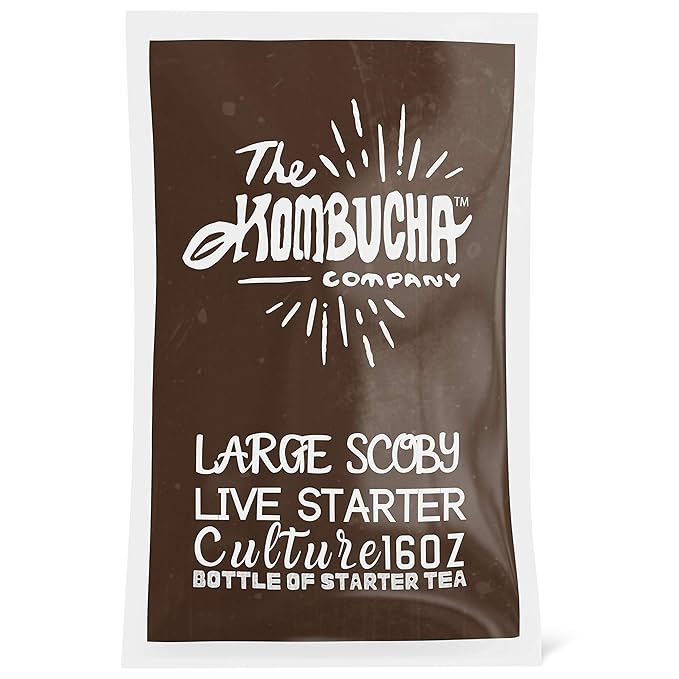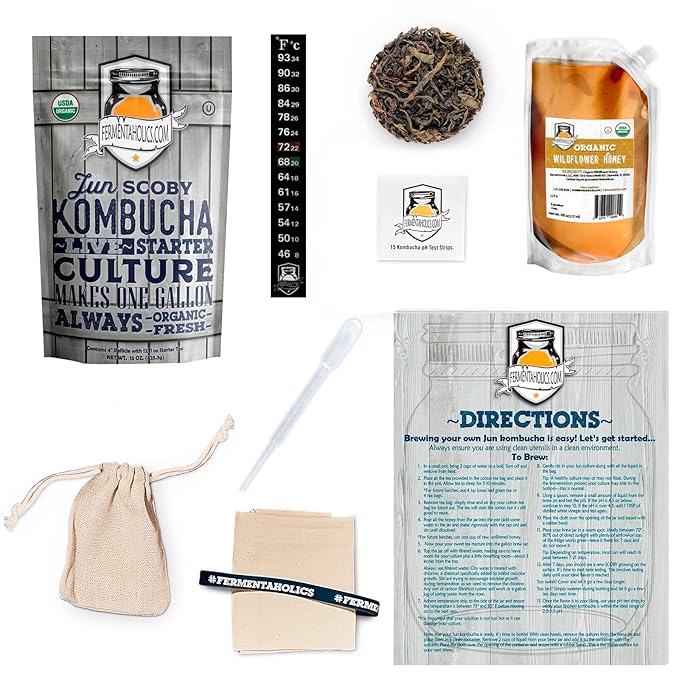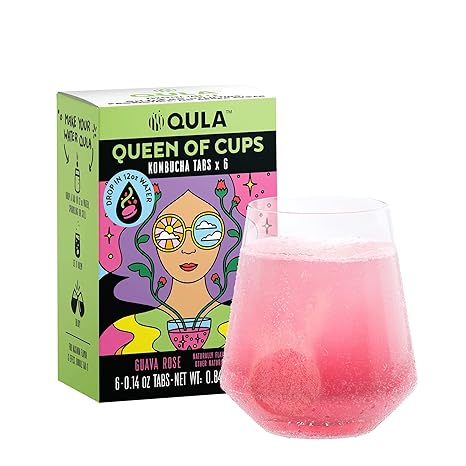Before brewing my own Kombucha I was purchasing store brands of Kombucha. Like many people I thought “this is what Kombucha tastes like. It was not until I was introduced to making my own at a tea festival in Kansas City Missouri, that I realized the difference.
I purchased a kit and never looked back. I’ll share that same recipe that started my brewing journey. The original SCOBY I purchased is still growing and going. My SCOBY has been shared with many people along the way. You can grow your own SCOBY. The process is a bit tedious. With so many opportunities to have one already created it is the better choice.
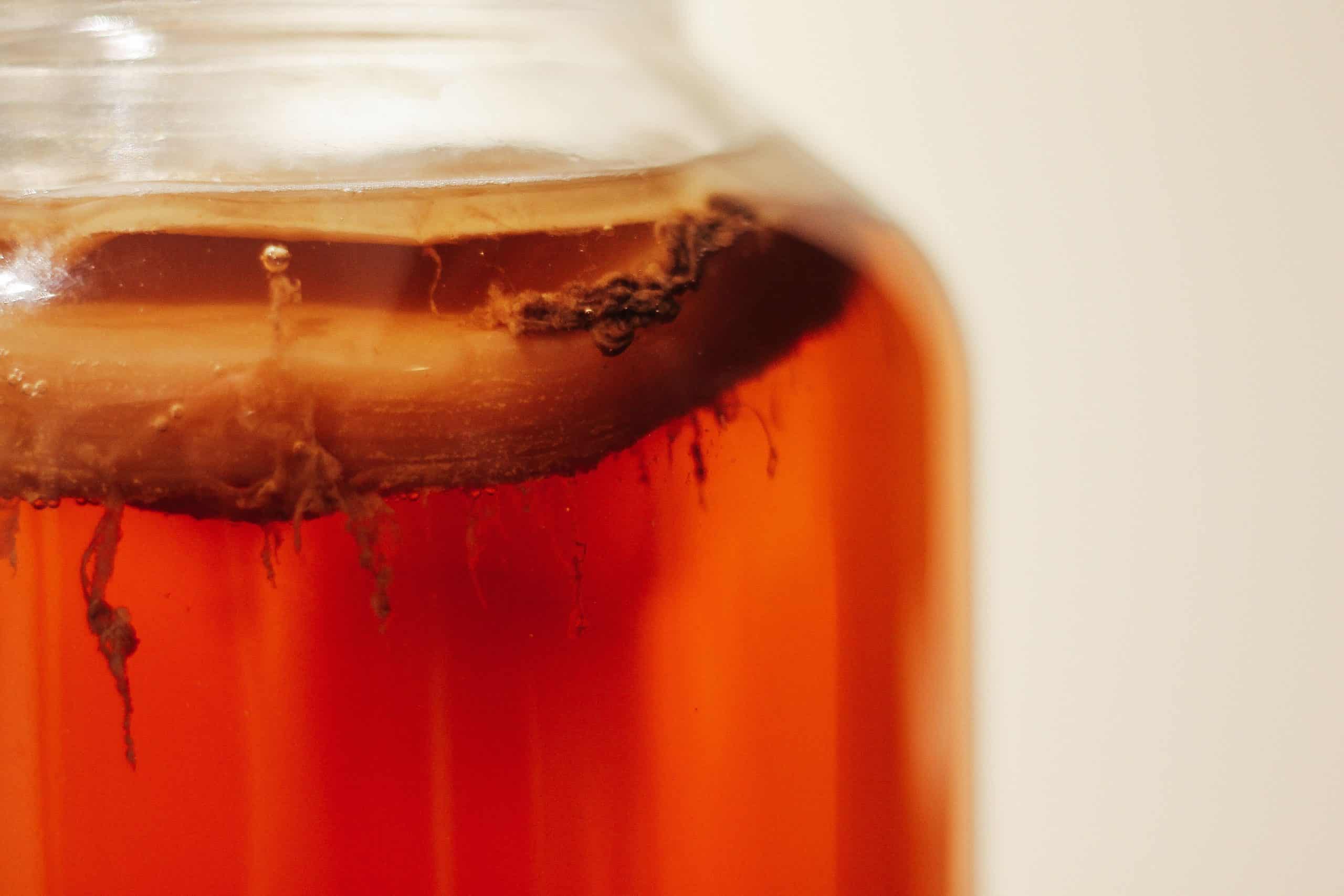
Kombucha has been around for centuries. Kombucha originated in Northeast China around BC 200. Kombucha was originally used for its health benefits. The name Kombucha is said to have come from Dr. Kombu (Korean) who brought the beverage to Japan for his Emperor. To learn more about Kombucha visit Kombucha: The Benefits, Risks, and Nutrition
The ingredients are simple, there are only three, to begin with:
-
Tea
-
Water
-
Sugar
-
and our SCOBY
The taste can be somewhat bitter and sweet. The Kombucha becomes more acidic (sour, tangy, bitter) the longer it brews.
Kombucha is a fermented drink. Fermentation happens by adding a SCOBY (we will talk about this in a few paragraphs) to the beverage. Then allowing that beverage to “ferment” and brew. While the tea is fermented the level of alcohol is very low. The yeast in the SCOBY gobbles up the sugar and produces ethanol and carbon dioxide. The alcohol and the bubbles. The bacteria in the SCOBY then gobble up ethanol and makes an organic acid. So there is alcohol present but it’s a consent exchange going on so the alcohol level is very minute. The bacteria and yeast working together keep the levels balanced.
Kombucha is a fizzy, somewhat carbonated, drink and is often referred to as a good alternative to soda.
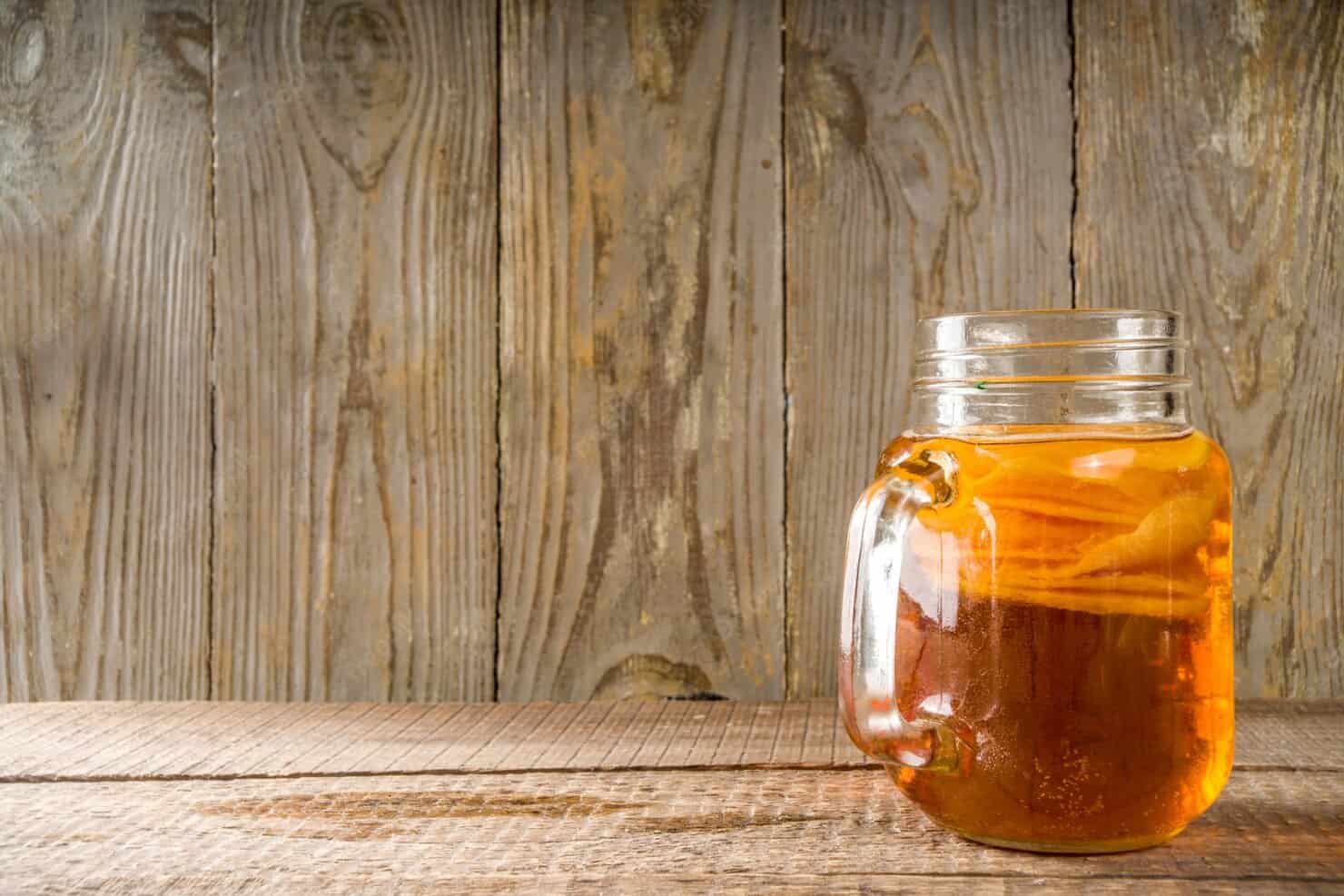
The SCOBY
SCOBY is an acronym for Symbiotic Colony of Bacteria and Yeast. The SCOBY is also referred to as:
-
The Mother: because it gives birth or grows
-
The Mushroom: because it looks like a mushroom
A SCOBY is the shape of a disk. If you are fermenting in my home and the SCOBY may be cut into any shape that happens to fit what I am doing. I was first afraid to touch the SCOBY it’s feel was like a hard gummy bear and it will be wet. After touching it the first time I realized it was not slimy and had a good feel to it.
You cannot hurt the SCOBY, the only thing that will take a SCOBY down is mold. Generally, all SCOBY will grow and fit into the container you choose. That container is almost always round.
It’s the yeast and bacteria that gobble up the sugar in our brew that makes the fermentation process happen. Without our SCOBY, we’d not have an amazing beverage like Kombucha.
Benefits of Kombucha
-
Kombucha detoxifies and shields the body from oxidative damage by the organic acids. Antioxidants lookout for free radicals and neutralize them. This allows the body to repair and protect from diseases and infections.
-
Kombucha is an incredible body detoxifier by uses glucuronic acid. That acid combines with the toxins inside the liver and expels them through the kidneys. That reduces stress on both the liver and the pancreas
-
Kombucha creates a healthy nervous system by combining amino acids and other nutrients. This stops the release of stress hormones, battles depression, and stabilizes moods. It also helps you get more rest.
-
Depression can be a symptom of a leaky gut, Kombucha helps heal the gut and in turn, heal your mental state. A gut that is exposed to healthy acids, probiotics, and enzymes calms the digestive system.
-
Healing the gut kombucha helps relieve the pain and discomfort from gastric ulcers.
-
The added antioxidants from the Kombucha help boost the immunity of the body. The body in turn defends itself against disease, bacterial and viral infections.
-
There is theophylline in Kombucha which is known for helping asthma. Theophylline is anti-inflammatory in nature. Kombucha’s anti-inflammatory properties aid in healing other diseases as well. There was a study done by Chinese scientists about the inhaling of Kombucha but, I do not suggest that in the least.
-
May help lower triglycerides as some studies have sown in animals. May also help to regulate cholesterol.
-
Managing diabetes would depend on the sugar content of the fermented Kombucha.
-
Kombucha detoxifies the body and can help heal damaged cells from oxidative stress.
-
Think of it this way: Good bacteria vs Bad bacteria. Kombucha contains good bacteria. Once ingested it goes to work against the bad bacteria. Kombucha has been shown in lab studies to have a positive effect against staph, E. coli and salmonella, and more.
-
Athletes that use Kombucha will tell you it works. What works is the glucuronic acid that detoxifies the body and helps the body rebuild tissue.
Loose leaf Green and Black Tea provides a balanced diet for active yeast and bacteria, allowing them to ferment in peak condition.
Nutritional Benefits of Kombucha
A study conducted by Alan J. Marsh found the following good bacteria that are within Kombucha Gluconacetobacter – a common strain of bacteria. This produces acid from the alcohol during the fermentation. This process decreases the alcohol contents and raises the probiotic agents.
-
Acetobacter – helps to reduce inflammation, and lowers blood pressure. Keeps blood sugar levels from spiking.
-
Lactobacillus – helps prevent the growth of harmful bacteria.
-
Zygosaccharomyces – creates cellulose a complex carbohydrate and reduces cholesterol. Helps with Irritable Bowel Syndrome and vaginal infections.
Kombucha also contains:
-
Polyphenols
-
Amino acids
-
Organic acids
-
Minerals
-
Enzymes
-
B1 (thiamine)
-
B2 (riboflavin)
-
B3 (niacin)
-
B6 (pyridoxine)
-
B9 (folic acid)
-
B12 (cobalamin)
-
Vitamin C
-
Oxalic acid
-
Acetic acid
-
Glucuronic acid
-
Usnic acid
-
Fructose
-
Lactic acid
While some may worry about calories and the contents. Below is a nutritional list from a popular brand of Kombucha located in most grocery stores:
-
Serving Size: 8 fluid ounces
-
Servings per container: 2
-
Calories: 30
-
Total Fat: 0.0 g
-
Cholesterol: 0.0 mg
-
Sodium: 10 mg
-
Total Carbs: 7.0 g
-
Sugars: 2.0 g
-
Protein: 0.0g
-
Vitamin B6: 20.0
-
Folic Acid: 25.0
-
Vitamin B12: 20.0
This kit has everything you need to start brewing your own kombucha at home. Our best in the industry kombucha cultures, equipment, and instruction will turn you into a kombucha-brewing rockstar in no time
Why Make Your Own
-
Great replacement for soda because that fizz will be a great substitute for a Soda and the brew has a little kick to it. Think “ahhhh”.
-
Making your own brew will save you a lot of money considering a store-purchased Kombucha is 3,5, or more dollars.
-
Very Easy To Make as you can see from the recipe above.
-
You are in control of ingredients and brewing times. so you are making kombucha to your exact liking and not something that is being bottled by the hundreds.
We have one of the most engaged communities of kombucha fanatics in the world! Since 2006, we’ve built a kombucha starter community of over 400,000 first time brewers, who have all elevated to become veterans!
How To Prepare Kombucha
How to handle brewing supplies and Scoby
-
When handling any of the Kombucha items it’s very important that your hands are clean
-
Try not to handle the SCOBY while it is brewing
-
Do not use a detergent to wash your hands or utensils in
-
Use a mild dish or bar soap
Here is what I do when handling the SCOBY. I spray down my hands, plate, and utensils with organic white vinegar. I did not learn this anywhere it made sense to me. It’s a way to make sure the SCOBY is not destroyed by any mold or bad bacteria. It’s an added level of clean hands and utensils.
Temperatures / environment
SCOBY loves warmth, not heat but warmth. Brewing in the winter months can be more challenging. You can buy a heating mat to encourage your fermentation. The best temperatures are between 68 and 78 degrees Fahrenheit. Kombucha can brew at higher temps yet the flavor will be a lot stronger. You can destroy your SCOBY at temperatures higher than 90 degrees. You will rock your SCOBY to sleep below 60 degrees.
How to Store Kombucha
Glass or Ceramic is the only way you should store your Kombucha. Remember your Kombucha is brewing and fermenting. You don’t’ want to take a chance on any other sort of material that may inhibit or harm your Kombucha.
-
jars
-
bottle
-
ceramic jugs
My first few brews were made in one-quart wide-mouth mason jars. This is the recipe that I will be sharing with you. It’s about getting started and getting familiar and you will grow from there.
ORGANIC KOMBUCHA SCOBY made by a US-based brewery ensures the highest-quality ferment starter for your at-home kombucha tea. Sustainably sourced organic ingredients ensure the best SCOBY starter.
How to Start Your Next Batch of Kombucha
Plan to start your next batch of Kombucha at the same time you are bottling your first batch for its 2nd ferment. If you don’t want to make another batch immediately. In the paragraphs below I will share with you how to store your SCOBY.
Recipe
I’d like to share the same recipe that got me started home brewing. The original SCOBY I purchased is still growing and going. My SCOBY has been shared with many people along the way. As the original one was shared with me.
You could grow your own SCOBY. The process is a bit tedious. With so many opportunities to have one already created it’s the better choice.
The SCOBY is a very important part of the brewing process. Without it, you will have no fizz no brew.
Make sure your SCOBY is healthy with no greenish or blue shades. Brown can be a presenting color on a SCOBY and a healthy SCOBY is an off-white shade.
The following recipe is the one I started with and still use today. I want to thank Mana Bar– Kansas City Missouri for sharing it with me and allowing me to share it with you.
-
1. Mix one quart of water with ½ cup of sugar in a cooking pot, bring to boil, stirring to dissolve.
-
2. Remove from heat and let cool for 5 minutes
-
3. Add 3-4 teaspoon tea to a muslin cloth bag
-
4. Let steep 15-30 minutes
-
5. Remove tea and let the concoction cool to blood temperature
-
6. Transfer to a quart-sized jar and add kombucha SCOBY and starter liquid
-
7. Cover with fabric (to keep flies and dust out) and store in a warm place out of direct sunlight for 1 to 2 weeks.
-
8. Taste after a week. When it is at its desired strength, stain liquid and refrigerate or at this point, you can do a second ferment
-
9. Drink and enjoy, or try mixing it with citrus soda, ginger beer, soda water, or any kind of juice.
-
10. Give the old mushroom to a friend, reserve it to make more, and feed it to your compost, but please do not throw it away.
It’s that simple.
The recipe above is considered your 1st ferment and if you want to stop there and consume your Kombucha you may. But, if you’d like to add more flavor and experiment more we can move on to the 2nd ferment.
The 2nd ferment is where you pour your brew into another container with a cap on it. The best for this are used Kombucha bottles, and spring top bottles (I buy mine at Ikea). Leave some space at least a couple of inches. This is where you can add your flavors:
-
Fruits
-
Berries
-
Herbs
-
Spices
-
Chia Seeds
-
Puree
-
Maple Syrup
-
Fruit Juice
-
Combinations of the above
My most recent combination was lavender mint but the sky’s the limit. I have friends that use tomatoes, chili peppers, and more. It’s up to you and your taste buds.
Never complete filling a bottle. Leaving room allows space for the brew to breathe and expel the gas that makes all the fizz happen. When the fizz does happen you will need to “burp” the bottle. Failing to burp (release the gas) the bottle will result in a shattered mess all over your kitchen.
**Avoid powdered spices they never mix well and are more of a problem than a benefit. Use only whole spices.
BREW WITH CONFIDENCE ★ Our easy instructions guide you step by step through your first fermentation. If you have questions, we are here and happy to help!
Oh no, it won’t fizz!
Third Ferment Fizz Hack
Sometimes, no matter how well you have prepared and bottled. You might open up a bottle of kombucha only to find it is flat. It’s still fine to consume. But, we love the bubbles.
There is a trick for this, which could be thought of as ‘third fermenting’. All you need to do is take the bottle and leave it at room temperature for a couple of days. If it is super sour, then you might want to add a little sugar, honey, or fruit juice. The extra sugar will kickstart the yeasts and help them to ferment a bit and build up new levels of carbonation. Adding honey at this point is safe while is not suggested for 1st fermentation. This added touch can kick start your ferment to the fizzy stage looked for in Kombucha.
Continuous Brew
Continuous Brew is exactly that. A continuous method of brewing the tea and generally done in a crock with a spout. The crock can also be elevated off the counter by a stand.
Equipment needed
For me, this was the most time-consuming of all. Gathering all the equipment I needed to make sure my Kombucha would be brewed. In the beginning, I was so worried about all the things to worry about. Today, I use the same process without much forethought and get a great brew every time.
-
Distilled white vinegar (for cleaning)
-
Water – filtered is always best (I use my Berkey water) no chlorine or fluoride)
-
Quart or gallon size glass jar
-
Jars for brewing your Kombucha in
-
Plastic, metal, glass
-
Fizzy build-up
-
Tops (rubberband, muslim)
-
Tea
-
Sugar
-
Turbinado raw organic
-
Plastic or wooden spoon for stirring
-
Scoby
-
Where can you get one
- Many links in this article
-
Friend
-
This is by far the best place to get your SCOBY. Ask around, join a group and get your SCOBY from someone who has fermented before. The only rule I would have is that they did not 2nd ferment with the SCOBY.
-
Shopping
-
There are various places online where you can buy a SCOBY and starter.
-
Grow your own
-
It is possible to grow your own SCOBY from store-purchased Kombucha, it is time-consuming. I don’t think it’s needed since there are so many other better ways to get one.
-
Scoby Hotel
-
A SCOBY hotel is a place to store your excess SCOBY. You will have excess. At times you can’t give it all away and it’s important to have a small supply of your SCOBY around. Just in case. I use a quart mason jar with some tea. The SCOBY will grow and you will have to feed it, but not as often.
-
-
Cover
-
Strainer
-
Funnel
-
Bottles
-
PH Strips
-
Temperature strips
-
Heating pads
-
Muslim tea bag
-
Labels
How To Use
Moderation is the key to drinking Kombucha. Start with ¼ cup a day and work up to a full serving. One serving per day is adequate.
Some things you will need to remember
-
Do not use decaffeinated tea
-
Do not use honey or artificial sweeteners
-
Do not mess with your SCOBY or brew while fermenting
-
Share your SCOBY with family and friends
-
Mold can happen when it does discard everything start over with clean jars and use a SCOBY from your hotel.
-
Exploding jars can happen. You need to burp the jars and be cautious about opening bottled Kombucha. You can use a towel to wrap around if you are unsure of the carbonation.
-
Fruit flies love Kombucha. During their season be careful with opening and closing your Kombucha. One of those little flies can destroy an entire batch of Kombucha.
Is Kombucha right for everyone?
-
Drinking an excessive amount of Kombucha could have some reactions. Reactions like nausea, headache, upset stomach, or allergic reactions.
-
The following is a list of conditions that may not benefit from consuming Kombucha
-
Kombucha is dampening and with any yeast infection, you want to dry it and not add any dampening to it.
-
Kombucha is acidic and if you have soft enamel or dental issues Kombucha is not a good fit.
-
Digestive issues such as IBS or Crohns can be affected by the levels of caffeine in Kombucha. Caffeine levels are low, but it may still cause a flare-up in digestive disease.
-
Suppressed immune diseases such as HIV/AIDS can be affected by the yeast that grows in Kombucha.
-
Because Kombucha does contain caffeine, even in lower doses. If you are avoiding caffeine then you should avoid Kombucha as well.
-
I have a friend who does not like alcohol and he said Kombucha reminds him of wine and he does not like it. Kombucha is fermented and does turn into a bit of alcohol.
-
Kombucha does contain small amounts of caffeine and alcohol. It’s suggested not to be consumed by young children or pregnant women.
New kombucha products
The world of kombucha is growing and recently I came across kombucha tablets. I purchased it and found it very interesting. If you don’t have the time and are not into the super sugary tasting store-purchased kombucha you can try it there.
Just drop it in water and make your own fresh brewed kombucha! You don't need a bottle, when you can simply drop a tab in water, let it brew, and drink the goodness
Final Thoughts
Since brewing Kombucha I’ve experienced the highs and the lows. It’s all part of the learning experience. The day a fruit fly got into your brew and you have to start over. Yes, it happened and I was so sad. The importance of a SCOBY hotel for backup is so vital.
Brewing kombucha has been rewarding. Not only by creating a healthy fizzy drink but by consuming it and sharing it with friends. If you come to my house I put a shot glass on the table and ask if you want to try my latest creation.
Today’s creation is Lavender Mint straight from my garden. What will you brew?
Before brewing my own Kombucha I was purchasing store brands of Kombucha. Like many people I thought “this is what Kombucha tastes like. It was not until I was introduced to making my own at a tea festival in Kansas City Missouri, that I realized the difference.
I purchased a kit and never looked back. I’ll share that same recipe that started my brewing journey. The original SCOBY I purchased is still growing and going. My SCOBY has been shared with many people along the way. You can grow your own SCOBY. The process is a bit tedious. With so many opportunities to have one already created it is the better choice.




